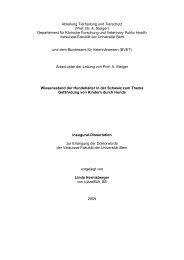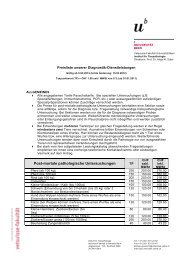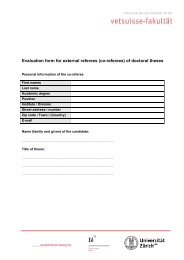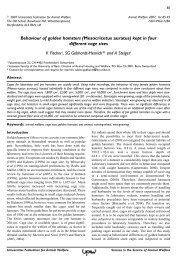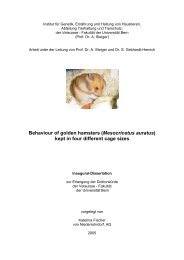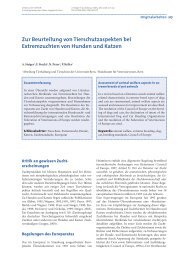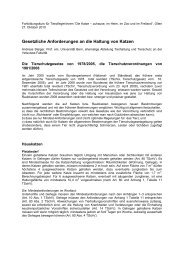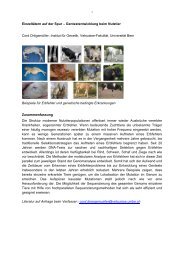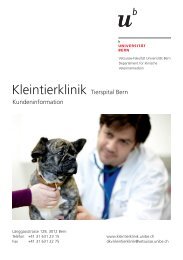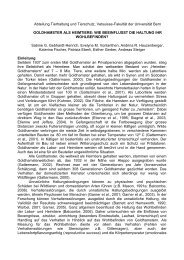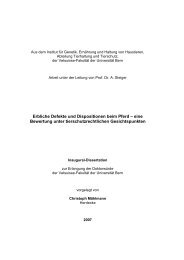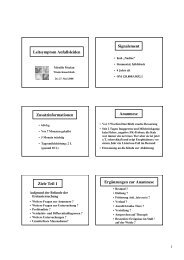Lifespan and Causes of Death in the Irish Wolfhound - Vetsuisse ...
Lifespan and Causes of Death in the Irish Wolfhound - Vetsuisse ...
Lifespan and Causes of Death in the Irish Wolfhound - Vetsuisse ...
Create successful ePaper yourself
Turn your PDF publications into a flip-book with our unique Google optimized e-Paper software.
On <strong>the</strong> o<strong>the</strong>r h<strong>and</strong>, <strong>the</strong> overdom<strong>in</strong>ance model postulates that <strong>in</strong>breed<strong>in</strong>g depression<br />
is not merely caused by <strong>the</strong> accumulation <strong>of</strong> recessive deleterious alleles, but ra<strong>the</strong>r<br />
results from a decrease <strong>in</strong> heterozygosis itself. Heterozygous <strong>in</strong>dividuals are thought<br />
to have <strong>in</strong>herently higher fitness values ("heterosis") than homozygous ones <strong>in</strong> this<br />
model, which may be <strong>in</strong>fluenced by epistatic gene effects.<br />
Current research po<strong>in</strong>ts to <strong>in</strong>breed<strong>in</strong>g depression be<strong>in</strong>g ma<strong>in</strong>ly due to partial<br />
dom<strong>in</strong>ance phenomena, although some contribution by overdom<strong>in</strong>ance cannot be<br />
ruled out (Charlesworth <strong>and</strong> Charlesworth 1987; Lacy <strong>and</strong> Ballou 1998; Crnokrak <strong>and</strong><br />
Barrett 2002).<br />
7.2.2.2 Lack <strong>of</strong> Inbreed<strong>in</strong>g Depression <strong>in</strong> O<strong>the</strong>r Models<br />
Examples for heavily <strong>in</strong>bred mammal populations with little to no apparent <strong>in</strong>breed<strong>in</strong>g<br />
depression are numerous <strong>and</strong> <strong>in</strong>clude, amongst o<strong>the</strong>rs, <strong>in</strong>bred stra<strong>in</strong>s <strong>of</strong> laboratory<br />
mice <strong>and</strong> rats, captive golden hamsters (Mesocricetus auratus), a subspecies <strong>of</strong><br />
Peromyscus polionotus (Lacy, Alaks et al. 1996; Lacy <strong>and</strong> Ballou 1998), Chill<strong>in</strong>gham<br />
wild cattle (Visscher, Smith et al. 2001), captive Speke's Gazelles (Templeton <strong>and</strong><br />
Read 1984), <strong>and</strong> Icel<strong>and</strong>ic horses (Sommerfeld-Stur, personal communication). The<br />
Kromfohrländer dog is also a likely c<strong>and</strong>idate due to its genetic history (Urfer <strong>and</strong><br />
Eberli, unpublished data; see chapter 7.2.3). Apart from mammals, such populations<br />
have also been described <strong>in</strong> plants <strong>and</strong> non-mammalian animals (Thornhill 1993).<br />
When enumerat<strong>in</strong>g such examples, however, it should be kept <strong>in</strong> m<strong>in</strong>d that <strong>the</strong>y do<br />
not <strong>in</strong> <strong>the</strong>mselves challenge <strong>the</strong> fact that <strong>in</strong>breed<strong>in</strong>g depression is a very real<br />
phenomenon <strong>in</strong> <strong>the</strong> majority <strong>of</strong> mammals, <strong>and</strong> that an apparent lack found <strong>in</strong> one<br />
population should always be considered <strong>in</strong> view <strong>of</strong> <strong>the</strong> population's genetic history, as<br />
well as its environment (Hedrick <strong>and</strong> Kal<strong>in</strong>owski 2000). Extrapolat<strong>in</strong>g <strong>the</strong> f<strong>in</strong>d<strong>in</strong>gs <strong>of</strong><br />
<strong>the</strong> study at h<strong>and</strong> to o<strong>the</strong>r populations may <strong>the</strong>refore be <strong>in</strong>appropriate.<br />
7.2.2.3 Allele Purg<strong>in</strong>g<br />
"Purg<strong>in</strong>g <strong>the</strong> genetic load" refers to a phenomenon that can occur if <strong>in</strong>breed<strong>in</strong>g<br />
depression is ma<strong>in</strong>ly due to <strong>the</strong> partial dom<strong>in</strong>ance mechanism: Dur<strong>in</strong>g phases <strong>of</strong><br />
cont<strong>in</strong>uous <strong>in</strong>breed<strong>in</strong>g, <strong>in</strong>dividuals that are homozygous for deleterious alleles have<br />
reduced fitness <strong>and</strong> consequently produce fewer <strong>of</strong>fspr<strong>in</strong>g, lead<strong>in</strong>g to a decrease<br />
<strong>and</strong>/or eventual elim<strong>in</strong>ation <strong>of</strong> such deleterious alleles from <strong>the</strong> population (Crnokrak<br />
<strong>and</strong> Barrett 2002).<br />
Fig. 7.2: Three possible scenarios for<br />
purg<strong>in</strong>g <strong>of</strong> <strong>the</strong> genetic load. No purg<strong>in</strong>g:<br />
fitness <strong>of</strong> <strong>in</strong>bred l<strong>in</strong>es cont<strong>in</strong>ues to<br />
decrease l<strong>in</strong>early with successive<br />
generations <strong>of</strong> <strong>in</strong>breed<strong>in</strong>g. Partial purg<strong>in</strong>g:<br />
<strong>in</strong>bred l<strong>in</strong>e fitness decreases <strong>in</strong>itially, <strong>the</strong>n<br />
rebounds to approximately 50% <strong>of</strong> outbred<br />
level. Complete purg<strong>in</strong>g: after an <strong>in</strong>itial<br />
drop, <strong>in</strong>bred l<strong>in</strong>es recover fitness values to<br />
levels comparable to orig<strong>in</strong>al level. Graph<br />
taken from Crokrak <strong>and</strong> Barrett (2002),<br />
modified after Lacy <strong>and</strong> Ballou (1998)<br />
98



